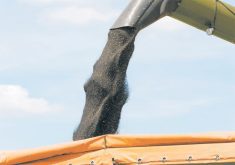Researchers were able to plunk powdery-mildew resistance into top wheat varieties in only a few months using genome-editing technology.
This shows the power of gene-editing methods in crop variety breeding, which often used to take years to move positive characteristics from their source to where they were needed, according to the lead researcher on the project.
“Genome editing has become very exciting in crop breeding and agriculture,” said Caixia Gao of the Institute of Genetics and Developmental Biology at the Chinese Academy of Sciences, during a Gairdner Global Perspectives Panel presentation.
Read Also

Soybean market still figuring out implications of China-U.S. pact
Soybean futures had a muted reaction to the U.S. trade deal with China as the market tries to figure out the nuances of the deal.
“Traditionally, we may take 10 years to breed a new crop. Now with genome editing, just in two or three months we have created a new crop variety with designer genomics.”
Gao’s team found genetics within wheat’s dauntingly complex hexaploid structure that offers powdery mildew resistance in plants possessing it.
It’s the same type of genetics that offer similar resistance to powdery mildew in barley, peas and tomatoes.
Using today’s CRISPR technology, researchers were able to get those resistant genes into elite commercial wheat varieties, cutting years from the usual crossing and backcrossing that makes traditional breeding such a challenge.
Wheat’s complex structure made it slow to join the genetic modification wave of the 1990s and 2000s, while consumer resistance to “frankenfoods” scuppered efforts to bring developed varieties to commercialization.
Gene editing, however, does not move genetics between species, as many GMO innovations do. Instead, it is used to pull beneficial genetics from part of the same crop species and drop them into specific varieties.
With powdery mildew destroying up to 40 percent of wheat crops in some parts of the world, and major wheat producers like China losing millions of acres to the disease, the ability to minimize losses is vital, Gao said.
This research project proved how valuable gene-editing can be to wheat and other crop breeding, she added.
“This finding highlighted genome editing as a powerful strategy directly and efficiently to generate elite wheat germplasm with robust powdery mildew resistance and enhanced crop growth and yields,” said Gao.
















